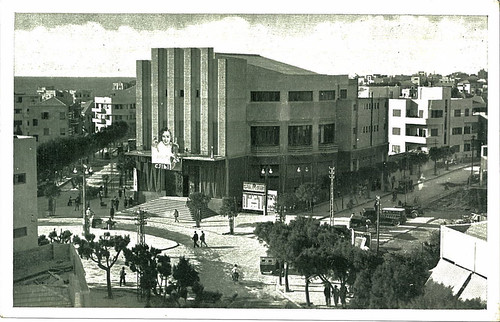Israelis love film. The current world wide success of large numbers of Israeli films is well known with the likes of Ronit Elkabetz, Adir Miller, Ohad Knoller, Amos Gitai and many other actors and directors receiving international acclaim. But the Israeli love affair with film is not something new. In the years following independence when money was scarce, people went to the cinemas in thousands to be entertained. A 1954 UNESCO study showed that residents of Haifa went to the cinema an average of 30 times a year, Tel Aviv residents 24 times and Jerusalemites 18 times, giving Israel the highest number of cinema visits per capita of any country in the world at the time. This began to change from the late 1960's onwards when television finally came to Israel and together with the decline in audiences, tragedy befell some of the country's best and most visually stunning cinemas.
The cinema pictured here - the Moghrabi, was perhaps the most famous of all. Designed by the eclectic style architect, Yosef Berlin for Syrian Jewish businessman Jacob Moghrabi and opened in 1930, not only did it sport many art deco features but after being roofless for the first few years, allowing screenings under the stars, a sliding roof was fitted in case of the odd rain shower. This feat of technology was not peculiar to the Mograbi and there was at least one other example of a sliding roof in Israel with the Armon Theatre in Haifa. But the Moghrabi seems to have left the most lasting impression.
Berlin was responsible for a number of Tel Aviv's buildings from this period including some stunning examples of the eclectic style. One of these was the Moghrabi House at 72-74 Herzl Street. I have been unable to find out if this is the same Moghrabi family as at the cinema - so if you have the answer please let me know!
As well as being a cinema, the Moghrabi staged plays and was the home of the Folk Opera in the 1940's. Trying to find out what the first film shown at the Moghrabi was, I came across a poster for sale on the internet, dating from 1930 and giving just that information. It reads "The gates of Opera Mugrabi will open soon and the pubic will come to see the wonderful building which was under construction for four years...the opening film will be the greatest of them all - Reo Rita". Another poster advertised the technological wonders of the Moghrabi "Which projector will screen films in the Moghrabi Opera? A Gaumont projector which is the most advanced of image projectors". Both posters were printed by Etin and Shoshani printing press, and demonstrate the confidence of the new state and its belief in modernity.
As well as being a cultural and social attraction and meeting place, the Moghrabi also witnessed some key moments in the history of the State of Israel. When the United Nations took its vote on partition in November 1947, great crowds gathered in front of the Moghrabi to await the result and danced in the street when the UN voted in favour.
Tragically, an electric short-circuit in the summer of 1986 caused a major fire which eventually led to the building being demolished leaving a huge void at the junction of Allenby and Ben Yehuda streets. From time to time there are plans and proposals put forward to rebuild at least the wonderful facade of the Moghrabi, but I am not aware of any of these being very far advanced. The picture postcard shown above is an iconic image of the cinema with its almost Egyptian style pillars and columns and the steps leading up to the great temple of film. Photographer Rudi Weissenstein's images of the cinema illuminated at night shows an impossibly glowing, glamorous, glorious building lighting up the city through the early years of independence and austerity. Such a loss. How many young Israelis saw their first movie or had their first date here I wonder? Memories and stories are welcome here!
You might also like this art deco cinema in Fiji or this post about Tel Aviv's eclectic architecture of the 1920's. Browse more photographs of Yosef Berlin's buildings here.

No comments:
Post a Comment